When Fujifilm unveiled its retro-styled, high-end X100 compact camera two years ago, it was received with rave reviews for the most part. Its autofocus speed, however, wasn't lightning fast - something the Fujifilm X100S, the updated follow-up to the original compact, looks to stamp out. How so? With the world’s fastest autofocus speed of just of 0.08 seconds, no less.
READ: Fujifilm FinePix X100 review
We had originally predicated that an "X200" would be launched at this year's Consumer Electronics Show in Las Vegas, Nevada, but the X100S is Fujifilm's alternative answer. It's more an improved and updated version than total overhaul.
The X100S comes complete with the same 23mm f/2.0 Fujinon fixed prime lens and body styling as its predecessor, but adds two key new features: a newly developed 16.3-megapixel APS-C-sized X-Trans CMOS II sensor with updated processor to match, plus a new, higher-definition hybrid viewfinder system.
The X100S's new sensor is far more than just a resolution jump. You've already spotted that silly "X-Trans" name again. This technology, as first featured in the Fujifilm X-Pro1 compact system camera, utilises a less conventional colour array that means the low-pass filter is removed from the design. The end result is far sharper images, but ones that still avoid moire and false colour. The original X-Trans CMOS in the X-Pro1 was an APC-C sensor marvel.
READ: Fujifilm X-Pro1 compact system camera review
While the X100S may share the same resolution as the X-Pro1 it's a new development and, paired with the EXR Processor II, there's every chance this high-end compact will produce Fujifilm's best image quality yet. We do hope so. Fujifilm claims that image noise has been reduced by more than 30 per cent compared to the original X100. Bonza!
The hybrid viewfinder - which merges a wider than 100 per cent optical viewfinder with a 100 per cent field-of-view electronic overlay (or separate electronic-only view) - is the same concept as in the original X100, but the X100S ups the electronic resolution to 2.36-million dots of resolution. That's about a million more than the original, so not to be sniffed at. There's also an optical power-save mode which can help to snap more shots per charge. Yup, the X100S shares the same battery as its predecessor.
Bizarrely, however, the rear LCD screen remains the same 2.8-inches, 460k-dot offering. It makes sense to avoid remoulding a new body, but would have been nice to see this pushed up to the next level too.
As we've already mentioned, autofocus - and, indeed, manual focus - is another big point that Fujifilm has, er, focused on. The X-Trans CMOS II sensor has built-in phase detection pixels on the sensor itself which, like other cameras such as the Canon EOS 650D, is said to provide the world's fastest AF response time. We're yet to be fully convinced by such a feature, so perhaps the X100S will change our minds when we get our first hands-on session with it.
READ: Canon EOS 650D review
Add half a second start-up time, half a second shot-to-shot time and a mere 0.01 seconds of shutter lag and the X100S is improved all round, by the sounds of things.
Manual focus also adds a "digital split image" mode which displays dual images on the left and right sides of view that can be lined up manually. Or, in other words, it's a half-way digital rangefinder function. Cool.
We loved the last model, and the latest X100S sounds like a belter. No news on price and release date as yet but, just like the original, we suspect this model will set you back somewhere close to the four-figure mark.
Keep eyes to the site for a hands-on with the Fujifilm X100S direct from the Consumer Electronics Show, Las Vegas, later on in the week.

